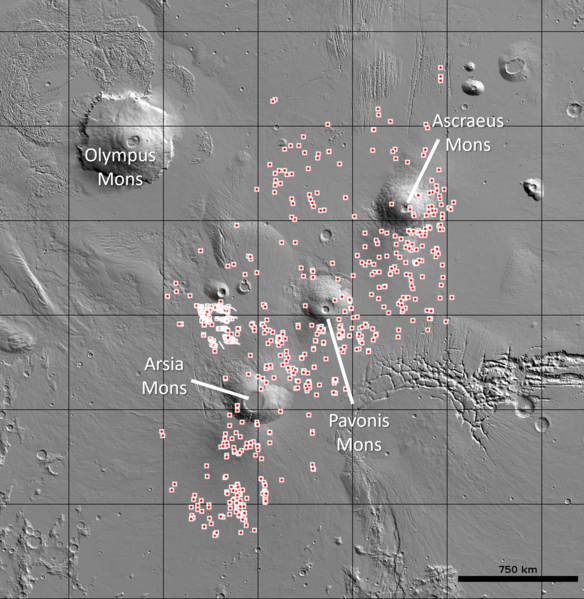File:Complete map of 1,000+ cave-entrances on Mars.png

Original file (2,412 × 2,475 pixels, file size: 5.88 MB, MIME type: image/png)
Captions
Captions
Summary[edit]
| DescriptionComplete map of 1,000+ cave-entrances on Mars.png |
English: The USGS Astrogeology Science Center has released locations of more than a thousand cave-entrance candidates on Mars.
The Mars Global Cave Candidate Catalog (MGC3) provides latitude and longitude coordinates, feature type, priority (confidence) rating, and a brief comment about each candidate. Types of cave entrances identified in the catalog include lava tube skylights, deep fractures, Atypical Pit Craters (APCs), and other void spaces in karst-similar terrains. Most entries in this catalog were identified through surveys of images from the Mars Reconnaissance Orbiter‘s (MRO) Context Camera (CTX) and High Resolution Imaging Science Experiment (HiRISE) cameras. CTX images show the Martian surface in visible (red) wavelengths at a scale of ~6 m/pixel, which is sufficient to identify sky-facing, shadowed cave entrance candidates as small as ~25 m across. Many of the highest quality candidates identified in the CTX survey were subsequently targeted HiRISE, which observes at scales as fine as ~0.25 m/pixel (about 1/500 of a single CTX pixel). This ultrafine resolution achieved by HiRISE is useful to determine which candidates (of those identified in CTX images) show evidence that subsurface cavities may extend beyond the observed line of sight (e.g., overhanging rims, surface skylights, etc.); this resolution also provides sufficient detail to characterize fine-scale surface features in and around the entrances such as aeolian bedforms, cliff-wall strata and dust/bedrock interfaces. Because all of these cave candidates were identified by spacecraft approximately 400 km above the Martian surface, it is impossible to see how far any of them extend beneath the surface. Not knowing which instances are caves and which are merely alcoves with modest lateral extent, we are careful to express that these are ‘candidate’ cave entrances. Caves may become important to the future of Mars exploration because they provide shelter from the entire range of harsh surface conditions while maintaining near-pristine interior surfaces and relatively stable microclimates. Mars’s thin atmosphere and negligible magnetic field do not effectively absorb, deflect, or moderate numerous hazards such as micrometeoroid impacts; dust storms; extreme temperature variations; and high fluxes of UV radiation, alpha particles, and cosmic rays. Because organic materials cannot continuously withstand such hazards, caves may be among the few human-accessible locations that preserve evidence of whether microbial life ever existed on Mars. Caves may also become valuable resources for human explorers, who would otherwise have to transport their own shelters or construct them in place. Additionally, exploring and characterizing Mars’s volcanic caves should enable us to constrain theories about lava-flow thermodynamics and hydrodynamics under Mars’s gravity and atmospheric conditions. Volcanic and other types of caves may also protect mineral formations that either do not form or become buried or altered under surface conditions. |
| Date | |
| Source | https://www.usgs.gov/center-news/caves-mars |
| Author | USGS Astrogeology Science Center |
Licensing[edit]
| Public domainPublic domainfalsefalse |
This work is in the public domain in the United States because it is a work prepared by an officer or employee of the United States Government as part of that person’s official duties under the terms of Title 17, Chapter 1, Section 105 of the US Code.
Note: This only applies to original works of the Federal Government and not to the work of any individual U.S. state, territory, commonwealth, county, municipality, or any other subdivision. This template also does not apply to postage stamp designs published by the United States Postal Service since 1978. (See § 313.6(C)(1) of Compendium of U.S. Copyright Office Practices). It also does not apply to certain US coins; see The US Mint Terms of Use.
|
 | |
| This file has been identified as being free of known restrictions under copyright law, including all related and neighboring rights. | ||
https://creativecommons.org/publicdomain/mark/1.0/PDMCreative Commons Public Domain Mark 1.0falsefalse
File history
Click on a date/time to view the file as it appeared at that time.
| Date/Time | Thumbnail | Dimensions | User | Comment | |
|---|---|---|---|---|---|
| current | 23:07, 3 August 2021 |  | 2,412 × 2,475 (5.88 MB) | Astroice7 (talk | contribs) | Uploaded a work by USGS Astrogeology Science Center from https://www.usgs.gov/center-news/caves-mars with UploadWizard |
You cannot overwrite this file.
File usage on Commons
There are no pages that use this file.
File usage on other wikis
The following other wikis use this file:
- Usage on en.wikipedia.org
- Usage on mk.wikipedia.org
Metadata
This file contains additional information such as Exif metadata which may have been added by the digital camera, scanner, or software program used to create or digitize it. If the file has been modified from its original state, some details such as the timestamp may not fully reflect those of the original file. The timestamp is only as accurate as the clock in the camera, and it may be completely wrong.
| Horizontal resolution | 129.92 dpc |
|---|---|
| Vertical resolution | 129.92 dpc |